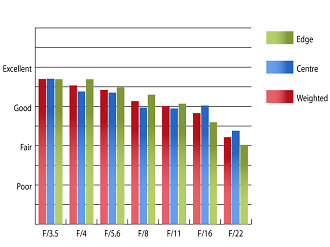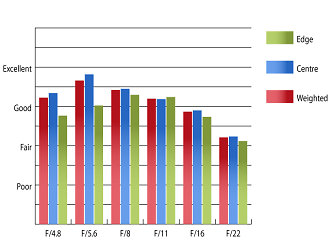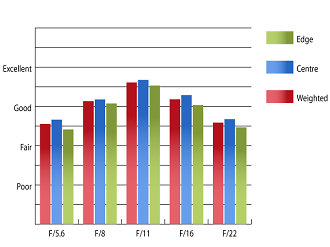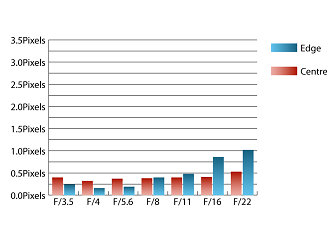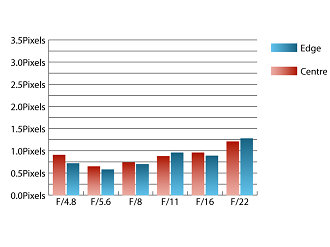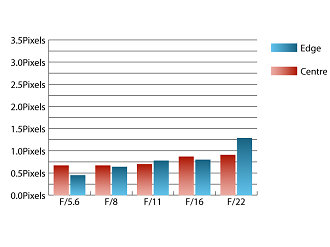Olympus M. Zuiko 14-42mm f/3.5-5.6 EZ ED MSC Lens Review
Olympus M. Zuiko 14-42mm f/3.5-5.6 EZ ED MSC Performance
At 14mm sharpness peaks at maximum aperture, producing very good clarity across the frame. Stopping down doesn't yield any increase in quality, as is often the case with MFT lenses that have a slow maximum aperture.
Zooming to 26mm results in a reduction in sharpness at maximum aperture, although good levels of sharpness are achieved in the centre of the frame. Clarity raises to very good levels in the centre and good sharpness towards the edges of the frame, with the aperture stopped down to f/5.6.
Finally, at 42mm peak performance drops further at maximum aperture, with the lens only producing fairly good sharpness at f/5.6. Stopping down to f/11 results in peak performance across the frame for this focal length.
How to read our charts
The blue column represents readings from the centre of the picture frame at the various apertures and the green is from the edges. Averaging them out gives the red weighted column.The scale on the left side is an indication of actual image resolution. The taller the column, the better the lens performance. Simple.
For this review, the lens was tested on a Panasonic Lumix GX7 using Imatest.
Chromatic aberrations are acceptably controlled, remaining below one pixel width throughout most of the zoom range. This level of fringing shouldn't pose too many issues, even in large prints, or harsh crops taken from the edges of the frame.
How to read our charts
Chromatic aberration is the lens' inability to focus on the sensor or film all colours of visible light at the same point. Severe chromatic aberration gives a noticeable fringing or a halo effect around sharp edges within the picture. It can be cured in software.Apochromatic lenses have special lens elements (aspheric, extra-low dispersion etc) to minimize the problem, hence they usually cost more.
For this review, the lens was tested on a Panasonic Lumix GX7 using Imatest.
Falloff of illumination towards the corners is fairly typical for a standard zoom lens, and shouldn't pose too many issues. At 14mm and f/3.5 the comers are 1.86 stops darker than the centre of the image and stopping down to f/5.6 results in visually uniform images. At 42mm, and f/5.6 falloff is about the same and the corners are 1.43 stops darker than the image centre and stopping down to f/8 results in visually uniform illumination.
Distortion is well controlled with only 0.983% barrel distortion at 14mm being replaced with only 0.376% pincushion distortion at 42mm. This low level of distortion should rarely require correction, but if it does, the distortion pattern is uniform across the frame throughout the zoom range, which should make applying corrections in image editing software afterwards, relatively straightforward.
No hood is supplied with this lens, probably because there is nowhere to attach it, also it would add to the bulk of the lens. Shooting into the light is no problem for this optic and it proved itself resistant to flare during testing.
Value For Money
Priced at £250 at launch, this lens is pretty keenly priced. The closest equivalent available is Panasonic's 14-42mm X Vario Power Zoom lens, or the 12-32mm Vario G Mega OIS lens, both collapse down to a similar diminutive pancake lens profile and also cost around £250.
Add your message
Please login here or if you've not registered, you can register here. Registering is safe, quick and free.
photodo Stats
428 MTF tests
74 in-depth photodo reviews
100+ users join each day
Help the lens community by reviewing or rating a lens today via our lens search
Latest Lens Reviews
- Chinon 28mm f/2.8 Vintage Lens Review
- Canon EF 70-200mm f/4L IS II USM Lens Review
- Samyang AF 85mm f/1.4 EF Review
- Sigma 70mm f/2.8 DG Macro Art Review
- Samyang AF 24mm f/2.8 FE Review
- Meike 50mm f/1.7 Review
- Tamron 70-210mm f/4 Di VC USD Review
- Lensbaby Burnside 35mm f/2.8 Review
- Asahi Super Takumar 50mm f/1.4 Review
- Asahi Super-Multi-Coated Takumar 135mm f/3.5 Review
